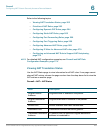
Firewall
Configuring NAT Rules to Securely Access a Remote Network
Cisco ISA500 Series Integrated Security Appliances Administration Guide 269
6
• Enable Port Triggering: Click On to enable the port triggering rule, or click
Off to create only the port triggering rule.
STEP 5 Click OK to save your settings.
STEP 6 Click Save to apply your settings.
Configuring Advanced NAT Rules
Advanced NAT allows you to identify real addresses and real ports for address
translation by specifying the source and destination addresses.
NOTE Up to 32 advanced NAT rules can be configured on the security appliance. You
must create firewall rules to allow access so that advanced NAT rules can function
properly.
STEP 1 Click Firewall > NAT > Advanced NAT.
STEP 2 To enable an advanced NAT rule, check the box in the Enable column.
STEP 3 To add a new advanced NAT rule, click Add.
Other options: To edit an entry, click the Edit (pencil) icon. To delete an entry, click
the Delete (x) icon. To delete multiple entries, check them and click Delete.
The Advanced NAT Rule - Add/Edit window opens.
STEP 4 Enter the following information:
• Name: Enter the name for the advanced NAT rule.
• Enable: Click On to enable the advanced NAT rule, or click Off to create only
the advanced NAT rule.
• From: Choose Any or choose an interface (a WAN port or a VLAN) that traffic
originates from.
• To: Choose Any or choose an interface (a VLAN or a WAN port) that traffic
goes to.
NOTE: When the original destination address is different with the translated
destination address, you must choose Any for this option. When the original
destination address is same with the translated destination address, you can
choose a specific VLAN or WAN port for this option.


















